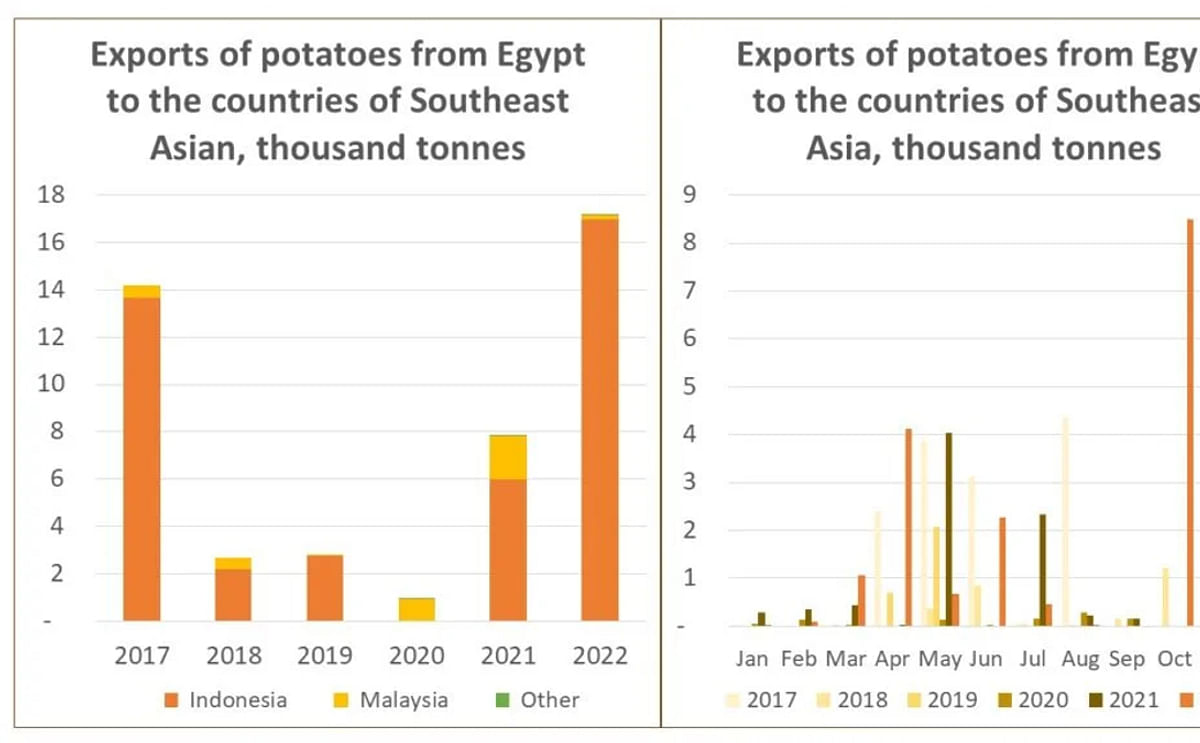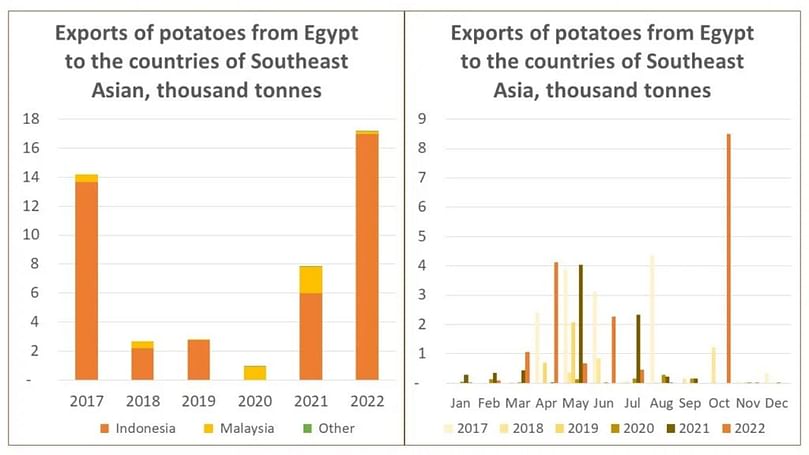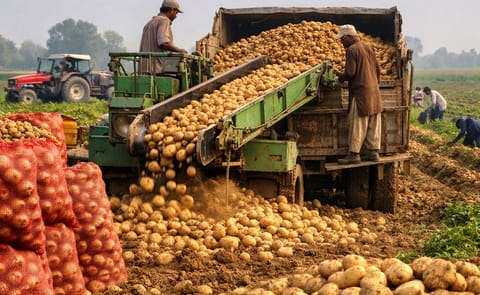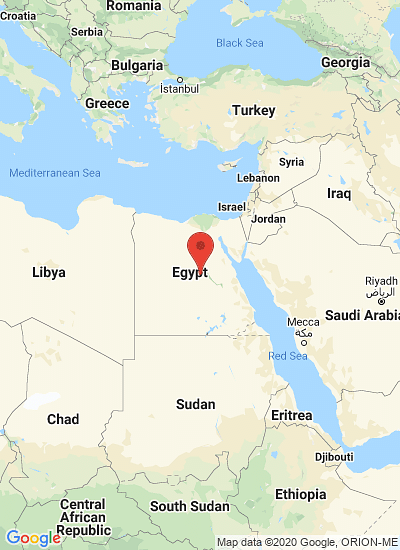Egypt potatoes exported to Southeast Asia
Egypt exported a record volume of potatoes to Southeast Asia in 2022

By the end of 2022, Egypt exported a record volume of potatoes to the countries of Southeast Asia, EastFruit reports. Indonesia remained the main destination for their supply, and exports more than doubled last year.
In total, over the past year, Egypt exported over 17 000 tonnes of potatoes to the countries of Southeast Asia, which exceeded the volume of 2021 by 120%, and compared to 2020, the volume of exports increased 18 times!
Indonesia remained the key destination for Egyptian exports, while deliveries to Malaysia declined sharply, and exports to other countries were minor.
 As a result, Southeast Asia became the fourth largest market for Egyptian potatoes after Russia, the EU, and the Gulf States last year. Interestingly, Egypt exported potatoes there not only in the traditional months of exports (spring-summer), but also in October, and the October exports helped get a record volume.
As a result, Southeast Asia became the fourth largest market for Egyptian potatoes after Russia, the EU, and the Gulf States last year. Interestingly, Egypt exported potatoes there not only in the traditional months of exports (spring-summer), but also in October, and the October exports helped get a record volume.
It should be noted that Indonesia is the leading potato producer in the Southeast Asian region, but it imports from 40 000 to 80 000 tonnes of potatoes annually. Moreover, in total, up to 450 000 tonnes of fresh potatoes are supplied to the region of Southeast Asia (Indonesia, Malaysia, Singapore, Thailand, Philippines, etc.), not to mention frozen french fries.
Potato is not a key crop for consumption in this region, like rice, but the local market for this product continues to grow through imports and local production. This applies to fresh produce and frozen french fries, the consumption growth of which is spurred by the development of tourism in the region.
As for the production of potatoes in the countries of Southeast Asia, despite the efforts of the local industry and the entry of international players, it is still highly dependent on the weather and the specifics of the tropical climate with its pests and conditions.
Noteworthy is the freezing phenomenon on the island of Java, which, according to local sources, produces about half of all potatoes in Indonesia.
If frost on plants early in the morning in the mountainous regions of the island in summer is an excellent opportunity for tourists to get beautiful shots, local producers call this phenomenon upas dew, which means "poisonous (or deadly) dew".
Depending on the season, upas dew can severely damage crops or lead to their loss, which may explain the atypical increase in imports during some months of the year.
The structure of potato imports to the countries of Southeast Asia is also very peculiar. About two thirds of the total are provided by four Asian countries (China, India, Pakistan, and Bangladesh). Basically, these potatoes are used for sale in local markets and ethnic shops.
The remaining third of imports are distributed among suppliers of good-quality potatoes from the EU countries (mainly Germany), North America, Australia, and Egypt. These products are already sold in local supermarket chains or are used for processing with specific requirements for raw materials that potato suppliers from other countries cannot meet.
In total, over the past year, Egypt exported over 17 000 tonnes of potatoes to the countries of Southeast Asia, which exceeded the volume of 2021 by 120%, and compared to 2020, the volume of exports increased 18 times!
Indonesia remained the key destination for Egyptian exports, while deliveries to Malaysia declined sharply, and exports to other countries were minor.

Egypt potatoes exported to Southeast Asia
It should be noted that Indonesia is the leading potato producer in the Southeast Asian region, but it imports from 40 000 to 80 000 tonnes of potatoes annually. Moreover, in total, up to 450 000 tonnes of fresh potatoes are supplied to the region of Southeast Asia (Indonesia, Malaysia, Singapore, Thailand, Philippines, etc.), not to mention frozen french fries.
Potato is not a key crop for consumption in this region, like rice, but the local market for this product continues to grow through imports and local production. This applies to fresh produce and frozen french fries, the consumption growth of which is spurred by the development of tourism in the region.
As for the production of potatoes in the countries of Southeast Asia, despite the efforts of the local industry and the entry of international players, it is still highly dependent on the weather and the specifics of the tropical climate with its pests and conditions.
Noteworthy is the freezing phenomenon on the island of Java, which, according to local sources, produces about half of all potatoes in Indonesia.
If frost on plants early in the morning in the mountainous regions of the island in summer is an excellent opportunity for tourists to get beautiful shots, local producers call this phenomenon upas dew, which means "poisonous (or deadly) dew".
Depending on the season, upas dew can severely damage crops or lead to their loss, which may explain the atypical increase in imports during some months of the year.
The structure of potato imports to the countries of Southeast Asia is also very peculiar. About two thirds of the total are provided by four Asian countries (China, India, Pakistan, and Bangladesh). Basically, these potatoes are used for sale in local markets and ethnic shops.
The remaining third of imports are distributed among suppliers of good-quality potatoes from the EU countries (mainly Germany), North America, Australia, and Egypt. These products are already sold in local supermarket chains or are used for processing with specific requirements for raw materials that potato suppliers from other countries cannot meet.
Like to receive news like this by email? Join and Subscribe!
Get the latest potato industry news straight to your WhatsApp. Join the PotatoPro WhatsApp Community!
Sponsored Content
Sponsored Content
Sponsored Content
Sponsored Content








